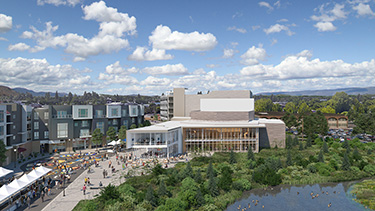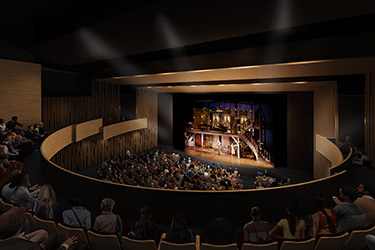|
Subscribe / Renew |
|
|
Contact Us |
|
| ► Subscribe to our Free Weekly Newsletter | |
| home | Welcome, sign in or click here to subscribe. | login |
Real Estate
| |
 |
July 30, 2020
Bold architecture blends with nature in the city
Knot

Hanks
|
The Patricia Reser Center for the Arts will be a destination not just for the arts, but also a showcase for the fast-growing city of Beaverton.
The Center for the Arts will offer the diverse Beaverton community a world-class destination where residents will come together for the arts, as well as for civic and social events.
At Knot — a Portland firm specializing in experiential graphic design, landscape architecture and ecological planning — the Patricia Reser Center for the Arts allowed our design team the opportunity to work with Opsis Architecture on a meaningful project that will unveil Beaverton’s natural beauties through bold architecture and design.
As a cultural jewel for Beaverton, the center will include a 550-seat proscenium theater for concerts, theater and dance, and an art gallery, exhibit space and outdoor plaza. Under construction and due for completion in 2021, the center will be a catalyst for economic and cultural growth in a city seven miles west of Portland that tech firms and Fortune 500 companies have called home for several decades.
Located between Beaverton Creek and a major light rail station, Reser Center is conceived as a regional attractor and cornerstone of a vibrant new urban development comprised of retail, restaurants, 230 housing units, a 125-bed hotel, and parking structure.
Knot’s team of graphic designers worked closely with Opsis, exploring design narratives that will complement the natural beauty of the adjacent Beaverton Creek through the use of natural materials. Our design choices respond to the natural site components and to the unique architectural qualities that emerged from Opsis.
Central to our effort, according to Knot’s experiential designer Jill Boots, was the development of an experiential design program that would bridge the greatest elements of the building’s design with its unique environment. The solution, Boots said, was the creation of a layered and integrated wayfinding system that subtly weaves through the space, blending together communication and architecture.
Equally as essential is a custom set of graphic symbols supporting an inclusive and welcoming environment for the community, while an artful donor acknowledgment celebrates the beauty of the adjacent Beaverton Creek and local support for the center.
Through a series of collaborative visioning workshops, contextual research and iterative design experimentation with the city of Beaverton, its mayor and Opsis, Knot gained a deep understanding of the project narrative and context.
The ultimate driver for Knot’s design process, these collaborative discussions offered invaluable insight to the site’s ecological importance, the center’s architectural language and its immense urban and cultural value. The final design is the result of a shared vision that pulls together community, architecture, culture and landscape.
Jim Kalvelage, founding partner with Opsis, said the design of Reser Center for the Arts celebrates the attributes of both the urban and natural context while weaving together into a harmonious relationship.
“The irregular site geometry — inscribed by Beaverton Creek and adjoining wetlands, the arc of Crescent Street and adjacent parking garage — informs an organic and bold architecture,” Kalvelage noted. “Discrete program elements are oriented to either the urban or natural context and composed into a varied massing sheathed in natural materials with a high level of porosity. The multi-level lobby overlooks Beaverton Creek and opens up to the Arts Plaza and Crescent Street, a venue for art festivals and celebrations.”
The pedestrian-oriented Crescent Street will be activated by Reser Center’s entrance and lobby of the 550-seat theater, art gallery and conference space. The cantilevered upper volumes of the experimental performance lab, conference room, and administrative suite provide a prospect and covered sidewalk and plaza areas.
“The transformative impact of the Reser Center design will define the cultural heart of Beaverton as an activity hub throughout the day and evening,” Kalvelage added. “As a destination for residents and visitors, it will be a catalyst for development in this evolving Cultural District. The Reser Center will redefine the civic setting with its iconic glass lobby facing outward to the community as an illuminated lantern reflected in the water of Beaverton Creek and viewed from Hall Boulevard, a major vehicular arterial in Beaverton. The stage tower is conceived as a civic landmark and canvas that will be painted at night with illumination and projections announcing performances and community events as viewed from both near and distant approaches.”
This legacy and the site’s proximity to Beaverton Creek along with the city’s desire to integrate wood into the public spaces inspired the metaphor of the “Beaver Dam” — an enveloping wood enclosure of engineered and artistic expression — for the design of the lobby and theater.
The lobby wall and ceiling are sheathed in fir panels with layered and varied patterns of sticks that extend to the fir curtain wall, framing views of Beaverton Creek, Kalvelage said. Daylighting through the glass wall and skylight create a constantly changing shadow play. The theater’s encompassing wood interior comprised of fir boards and panels with an intuitive pattern of incisions support the seamless integration of acoustical and theatrical systems to create a visually warm and intimate relationship between the audience and performers.
In a city with considerable natural beauty to share, Patricia Reser Center for the Arts challenged designers at Knot to embark on their own journey of exploration and discovery.
Knot’s crafted approach to our experiential graphic design program for the center will result in a venue that artfully bridges urban and natural environments and will be a catalyst for decades of transformative urban growth.
Marilee Hanks, owner and principal of the Portland landscape architecture/experiential graphic design firm Knot, is passionate about shaping the human experience of place and reinforcing the natural systems that sustain us.
Other Stories:
- Sustainable satellites: Saviors of our cities?
- Design, science and the brain
- The evolution of urban development on First Hill
- Life science thrives in urban hubs
- A radical rebalancing of the urban environment
- Landscape architecture in the time of COVID-19
- Seattle’s march toward legacy city
- The coming evolution of cities and public spaces
- Designing for a holistic community experience




